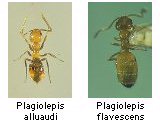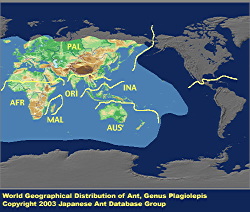
|
genus
|
Plagiolepis
|
 |

|
|
Japanese Name
|
Hime-ki-ari-zoku
|
Original Reference
|
|
Mayr, G. (1861) Die EuropŠischen Formiciden. (Ameisen.): 80 pp. Wien.
|
Synonym
|
|
Plagiolepis Mayr, 1861: 42,
Anacantholepis Santschi, 1914e: 36,
Aporomyrmex Faber, 1969: 52,
Paraplagiolepis Faber, 1969: 65
|
Description
|
|
Total length of workers around 4 mm or less. Body color light yellow to black (yellow to light brown in Japanese species). Eyes large, with 20 or more facets; their shortest diameters exceeding the width of an antennal scape; placed in the middle or anteriorly on sides of head. Three ocelli present but small and often obscure. Antennae 11-segmented; scape slightly exceeding posterior margin of head. palpal formula 6:4. Paired short, erect hairs present on posterior margin of head. Pronotum short, mesonotum small. Mesonotum and mesopleuron separated by a shallow groove with transverse short striae. Mesothoracic spiracles opening on dorsal surface of mesosoma. Propodeal spiracle placed on dorsal portion of lateral surface of propodeum. Petiole small, with small, rounded node.
|
|

|
Remarks
|
|
The Japanese species are somewhat similar to Tapinoma sp. 3 [Konuka-ari] of this work in size and general appearance. These ants are found in habitats ranging from open land to woodland, nesting under stones or logs. The detailed biology of Japanese species is not known. Inquilinism and worker oviposition have been reported in European species (Passera, 1966, 1968a, 1968b, 1980). Plagiolepis comprises about 30 species, and is distributed in the tropics to temperate zones of Africa and Eurasia. Several species have been widely spread by commerce. Two species are known from Japan.
|
References
|
|
- Passera, L. (1966). Fecondite des femelles au sein de la myrmecobiose Plagiolepis pygmaea Latr.-- Plagiolepis xene Star.(Hymenopteres, Formicidae). . Compt. Rend. Acad. Sci. Paris, Ser.D, 263, 1600-1603.
- Passera, L. (1968a. ). Les stades larvaaires de la caste ouviere chez la fourmi Plagiolepis pygmaea Latr. (Hymenoptere, Formicidae). . Bull. Soc. Zool. France, 93, 357-365.
- Passera, L. (1968b. ). Observations biologiques sur la fourmi Plagiolepis grassei Le Masne Passera, parasite social de Plagiolepis pygmaea Latr. (Hym. Formicidae). . Ins. Soc. , 15, 327-336.
- Passera, L. (1980). La fonction inhibitrice des reines de la fourmi Plagiolepis pygmaea Latr.: role des pheromones. . Ins. Soc. , 27, 212-225.
|
Editor
|
|
Original text by Kazuo Ogata. English translation by Kazuo Ogata, edited by Robert W. Taylor.
|
|